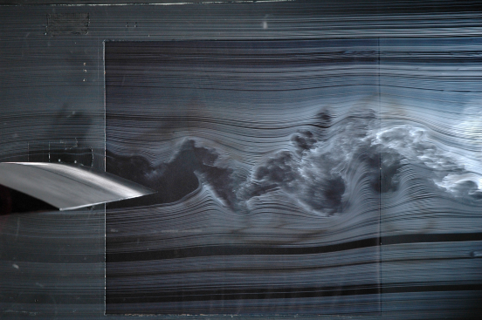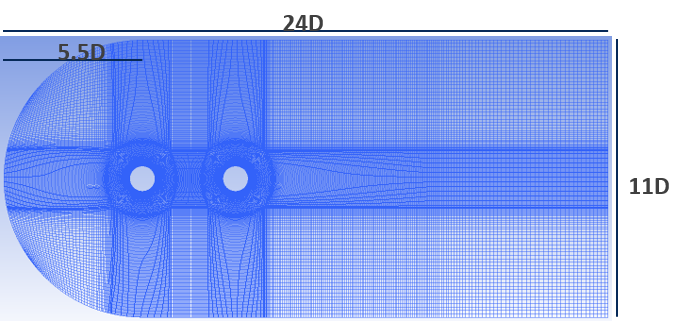| Aerodynamic Control | ||||||||||||||||
| Aerodynamic control of low Reynolds number flow using synthetic jet actuation is of great interest to a wide range of applications including the the design and operation of unmanned aerial vehicles (UAVs) at low speeds, separation control at the inlets of jet engines and the design of compressor blades. Different methods have been tested over the past several decades including continuous suction and blowing, vibrating ribbons, vortex generators, heat strips, external audio excitation and synthetic jet actuation. Each of these control methods has shown favorable results but not all have proven practical. For example, continuous suction, which removes slow moving fluid from the surface and causes a high momentum free-stream fluid to be deflected downward, and continuous blowing, which imparts stagnant fluid near the surface with additional momentum, both significantly reduce drag. However, because of complex plumbing and additional weight, any gains in lift would be canceled out by the additional weight and power required to operate the device. Over time, periodic excitation has emerged as a potentially cost-effective and efficient control method over other methods. Periodic excitation can be applied externally or internally.
This work has used both acoustic and mechanical control to elucidate physical mechanisms of the flow over a NACA 0024 airfoil. This has resulted in a characterization of external (acoustic) and internal (SJA) control. This work has been combined with my wind turbine work towards optimization of wind turbine power generation in the range of 1-5 kW within low wind speed regions, notably most of Ontario. |
 |
|||||||||||||||
| Aeroacoustics | ||||||||||||||||
| Quieter aircraft are necessary when incorporating airports into urban areas and the airframe is a significant source of noise, especially during landing. Landing gear noise is the major contributor to airframe noise. This work has the goal to calculate sound pressure levels (SPL) vs. frequency
Other work has been done to look at particular company needs. |
Mesh for LES Studies |
|||||||||||||||
| Improved Turbulence Statistics from Big Data | ||||||||||||||||
| PIV data processing is time consuming and is generally too slow for use with an active control system. This can put constraints on the size of datasets. A possible avenue is to massively accelerate analysis using GPUs. Depending on the algorithm, PIV algorithms have been accelerated up to 120x Furthermore, uncertainty quantification is an important part of data analysis, and is still an outstanding question in PIV. Multiple methods for uncertainty analysis have emerged, each with their own benefits and drawbacks. |
|
|||||||||||||||
Selected Publications
(2018) A numerical study on the influence of cavity shape on synthetic jet performance, International Journal of Heat and Fluid Flow 74, doi:10.1016/j.ijheatfluidflow.2018.10.001
(2018) Shear Layer Development, Separation, and Stability over a Low-Reynolds Number Airfoil, Journal of Fluids Engineering, Transactions of the ASME 140(7), doi:10.1115/1.4039233
(2018) Apparatus for the dynamic calibration of low-range differential pressure transducers, AIAA Journal 56(3), doi:10.2514/1.J056373
(2017) Influence of synthetic jet location on active control of an airfoil at low Reynolds number, Experiments in Fluids 58(8), doi:10.1007/s00348-017-2387-x
(2017) Three-dimensional span effects of high-aspect ratio synthetic jet forcing for separation control on a low Reynolds number airfoil, Journal of Visualization 20(1), doi:10.1007/s12650-016-0365-7
(2015) Flow reattachment using synthetic jet actuation on a low-reynolds-number airfoil, AIAA Journal 53(7), doi:10.2514/1.J053605
(2015) Influence of cavity shape on synthetic jet performance, Sensors and Actuators, A: Physical 223, doi:10.1016/j.sna.2014.12.004
(2019) Bi-global stability analysis in curvilinear coordinates, Physics of Fluids 31(10), doi:10.1063/1.5118365
(2018) A numerical study on the influence of cavity shape on synthetic jet performance, International Journal of Heat and Fluid Flow 74, doi:10.1016/j.ijheatfluidflow.2018.10.001
(2018) Shear Layer Development, Separation, and Stability over a Low-Reynolds Number Airfoil, Journal of Fluids Engineering, Transactions of the ASME 140(7), doi:10.1115/1.4039233
(2017) Sensitivity of the Orr–Sommerfeld equation to base flow perturbations with application to airfoils, International Journal of Heat and Fluid Flow 67, doi:10.1016/j.ijheatfluidflow.2017.06.005
(2015) Flow reattachment using synthetic jet actuation on a low-reynolds-number airfoil, AIAA Journal 53(7), doi:10.2514/1.J053605
(2013) Smoke-wire flow visualization of a synthetic jet, Journal of Visualization 16(1), doi:10.1007/s12650-012-0155-9
(2013) Smoke-wire flow visualization of a synthetic jet, Journal of Visualization 16(1), doi:10.1007/s12650-012-0155-9
(2009) Smoke-wire flow visualization in separated flows at relatively high velocities, AIAA Journal 47(6), doi:10.2514/1.43539
(2009) On vortex shedding from an airfoil in low-Reynolds-number flows, Journal of Fluid Mechanics 632, doi:10.1017/S0022112009007058
(2008) Separated-Shear-Layer Development on an Airfoil at Low Reynolds Numbers, AIAA Journal 46(12), p. 3060-3069, url
(2008) Unsteady Separated Flow Characterization on Airfoils Using Time-Resolved Surface Pressure Measurements, AIAA Journal 46(2), p. 508-516
(2008) Unsteady separated flow characterization on airfoils using time-resolved surface pressure measurements, AIAA Journal 46(2), doi:10.2514/1.33306
(2008) Separated-shear-layer development on an airfoil at low Reynolds numbers, AIAA Journal 46(12), doi:10.2514/1.36620
(2007) Effect of acoustic excitation amplitude on airfoil boundary layer and wake development, AIAA Journal 45(4), doi:10.2514/1.25439
(2006) Airfoil performance at low Reynolds numbers in the presence of periodic disturbances, Journal of Fluids Engineering, Transactions of the ASME 128(3), doi:10.1115/1.2175165
(2006) Coherent structures in an airfoil boundary layer and wake at low Reynolds numbers, Physics of Fluids 18(4), doi:10.1063/1.2187069
(2005) Airfoil boundary layer separation and control at low Reynolds numbers, Experiments in Fluids 38(4), doi:10.1007/s00348-005-0943-2
(2003) Effect of acoustic excitation on airfoil performance at low Reynolds numbers, AIAA Journal 41(8), doi:10.2514/2.2113
